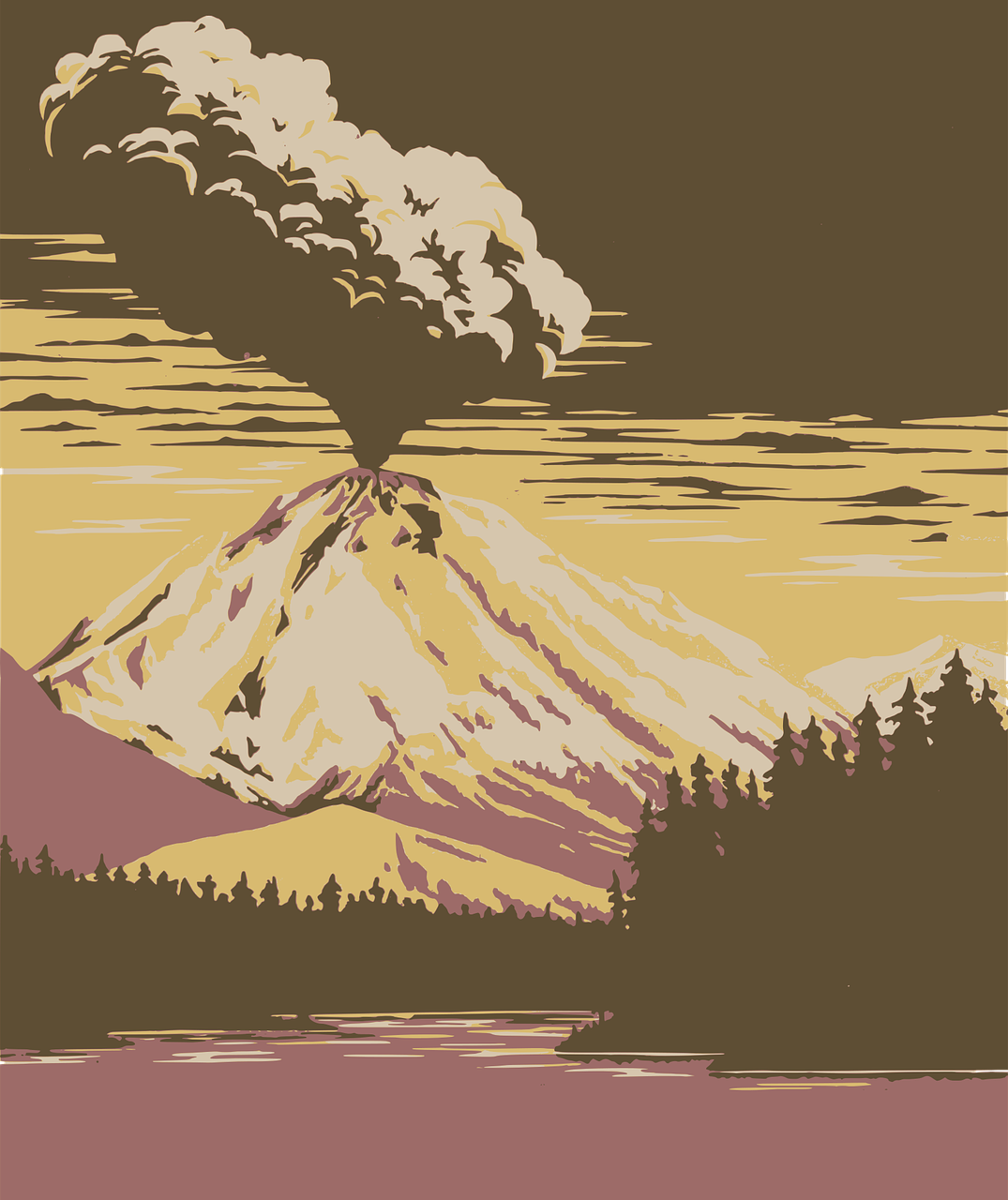Volcano
The diagram provides information about the Hawaiian island chain, which is located in the centre of the Pacific Ocean.
Looking from an overall perspective, it is evident that the island chain comprises 6 major islands, with Hawaii being the largest and Niihau the smallest, while the others are of medium sizes. Additionally, there are incremental directional transitions of the Pacific tectonic plate on an annual basis, and the process of volcano development involves four primary stages, from the eruption at the bottom to the formation of the volcano on the island surface.
The Hawaiian chain is characterised by four volcanoes, with the oldest in the northwest dating back 80 million years and the youngest in the southeast built up from numerous eruptions. These eruptions began 2883km below sea level, where a ‘hot spot’ spume remains immobile. Above this lies magma spume.
Moreover, the diagram also shows that the southeastern-to-northwestern shift of the Pacific tectonic plate is observed at a rate of 7cm to 9cm per year above a layer of solid dense rock. It also displays six islands, led by Hawaii in terms of size at approximately 100km x 100km, followed by Kauai, Oahu, Molokai, and Maui, all of which are roughly similar in size (25km x 25km), and finally, by Niihau, which has an insignificant area compared to the others.
(221 words)
Essay breakdown
Introduction:
[1] The diagram provides information about the Hawaiian island chain, which is located in the centre of the Pacific Ocean.
[2] Looking from an overall perspective, it is evident that the island chain comprises 6 major islands, with Hawaii being the largest and Niihau the smallest, while the others are of medium sizes. [3] Additionally, there are incremental directional transitions of the Pacific tectonic plate on an annual basis, and the process of volcano development involves four primary stages, from the eruption at the bottom to the formation of the volcano on the island surface.
- Write a general statement to introduce the topic
- Summarise the islands by their size
- Summarise other important information
Body 1:
[1] The Hawaiian chain is characterised by four volcanoes, with the oldest in the northwest dating back 80 million years and the youngest in the southeast built up from numerous eruptions. [2] These eruptions began 2883km below sea level, where a ‘hot spot’ spume remains immobile. Above this lies magma spume.
- Details of the four volcanos
- Details of the process of volcanic eruptions
Body 2:
[1] Moreover, the diagram also shows that the southeastern-to-northwestern shift of the Pacific tectonic plate is observed at a rate of 7cm to 9cm per year above a layer of solid dense rock. [2] It also displays six islands, led by Hawaii in terms of size at approximately 100km x 100km, followed by Kauai, Oahu, Molokai, and Maui, all of which are roughly similar in size (25km x 25km), and finally, by Niihau, which has an insignificant area compared to the others.
- The plate tectonic shift
- Details of six islands
Vocabulary:
The diagram provides information about the Hawaiian island chain, which is located in the centre of the Pacific Ocean.
Looking from an overall perspective, it is evident that the island chain comprises 6 major islands, with Hawaii being the largest and Niihau the smallest, while the others are of medium sizes. Additionally, there are incremental directional transitions of the Pacific tectonic plate on an annual basis, and the process of volcano development involves four primary stages, from the eruption at the bottom to the formation of the volcano on the island surface.
The Hawaiian chain is characterised by four volcanoes, with the oldest in the northwest dating back 80 million years and the youngest in the southeast built up from numerous eruptions. These eruptions began 2883km below sea level, where a ‘hot spot’ spume remains immobile. Above this lies magma spume.
Moreover, the diagram also shows that the southeastern-to-northwestern shift of the Pacific tectonic plate is observed at a rate of 7cm to 9cm per year above a layer of solid dense rock. It also displays six islands, led by Hawaii in terms of size at approximately 100km x 100km, followed by Kauai, Oahu, Molokai, and Maui, all of which are roughly similar in size (25km x 25km), and finally, by Niihau, which has an insignificant area compared to the others.
Vocabulary Highlights:
- Hawaiian island chain: a group of islands located in the Pacific Ocean.
- 6 major islands: there are 6 significant islands in the Hawaiian chain.
- Incremental directional transitions: gradual changes in direction.
- Pacific tectonic plate: a large plate that makes up the Earth’s crust and lies beneath the Pacific Ocean.
- Volcano development: the process of creating a volcano.
- Oldest in the northwest: the oldest volcano is in the northwest part of the chain.
- Youngest in the southeast: the youngest volcano is in the southeast part of the chain.
- Hot spot: an area of the Earth’s mantle that is hotter than the surrounding rock, resulting in volcanic activity.
- Magma spume: molten rock that has risen to the Earth’s surface and cooled.
- Southeastern-to-northwestern shift: movement in a particular direction.
- Pacific tectonic plate: a large plate that makes up the Earth’s crust and lies beneath the Pacific Ocean.
- Solid dense rock: hard and compact rock.
Diamond Grammar:
COMPLEX SENTENCE STRUCTURE + PASSIVE VOICE CONSTRUCTION
“Moreover, the diagram also shows that the southeastern-to-northwestern shift of the Pacific tectonic plate is observed at a rate of 7cm to 9cm per year above a layer of solid dense rock.”
This sentence includes the complex grammar structure of a passive voice construction, in which the focus of the sentence is on the object receiving the action rather than the subject performing the action. The verb “is observed” is in the passive voice, with the subject “the southeastern-to-northwestern shift of the Pacific tectonic plate” receiving the action, and the agent or doer of the action is not explicitly stated.
Reading:
Further reading about this topic can be found here:
Listening:
Further listening about this topic can be found here:


